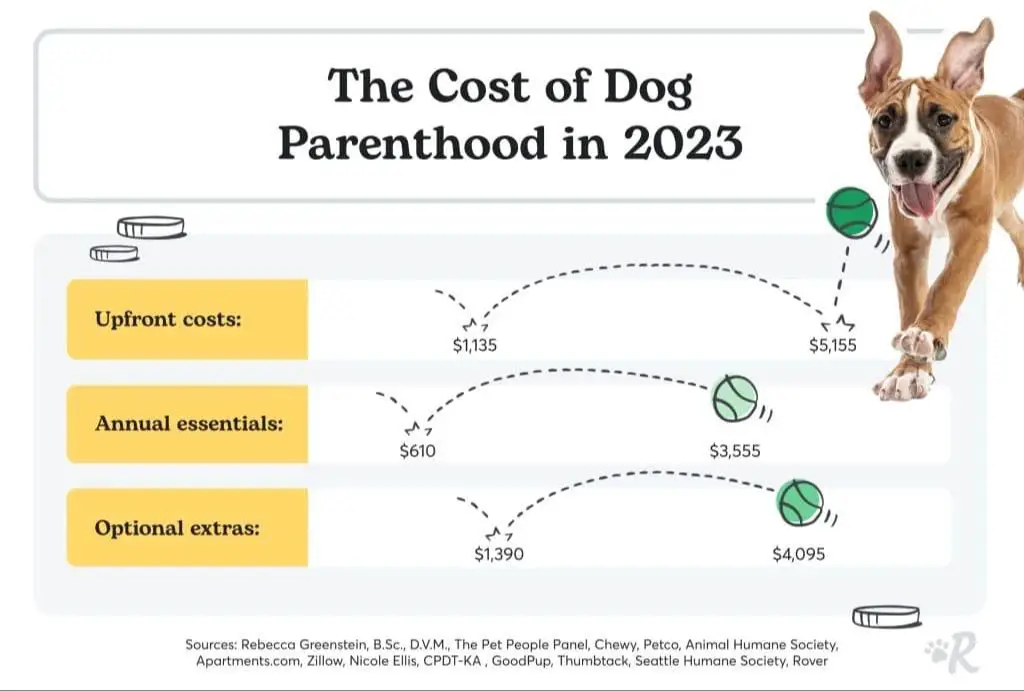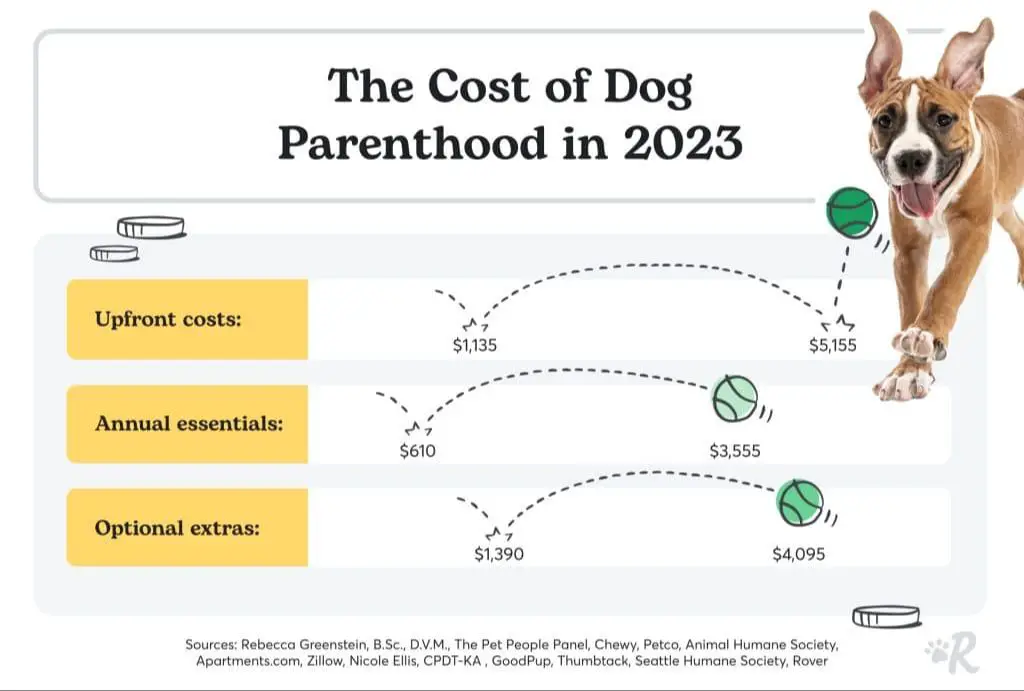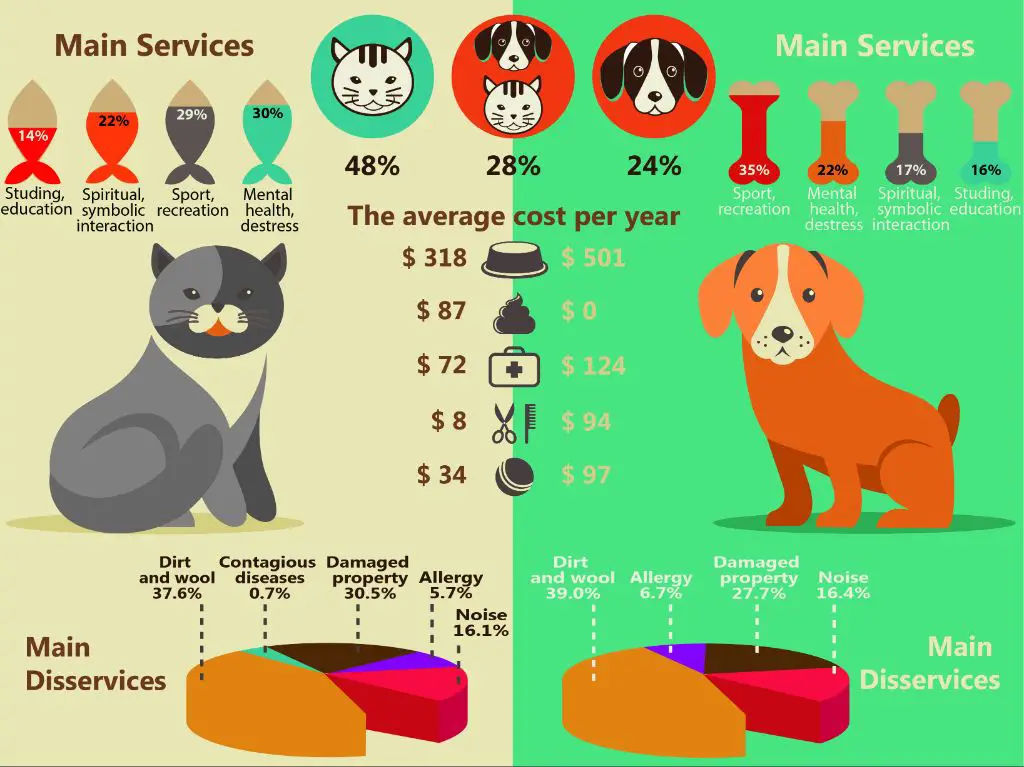Introduction
The expenses associated with dog ownership can really add up. According to a survey by USA Today, the average annual cost of owning a dog is a whopping $4,512 per year or $376 per month. With such a significant financial commitment required, it’s important for potential and current dog owners to understand all the costs associated with properly caring for a canine companion.
This article will provide a comprehensive overview of how expensive dog ownership really is, including a breakdown of one-time and recurring monthly expenses. We’ll also explore how costs vary based on breed, age, lifestyle factors, and geographic region. By the end, readers will have a clear understanding of the budget they need to own a dog responsibly.
One-time initial costs
The upfront costs of getting a new dog can range quite a bit depending on whether you adopt from a shelter, rescue, or breeder. Some key one-time expenses include:

Adoption fees
Adoption fees from shelters and rescues typically run from $50-$350 nationwide, with costs varying based on the breed, age, special needs and location of the shelter (Source). Purebreds and puppies often command higher adoption fees. Local humane societies and SPCAs tend to charge fees on the lower end, around $100-$200.
Supplies
New dog owners should budget $150-$300 for initial supplies like a crate, leash, collar, bowls, toys, bed, and puppy pads. Buying high-quality gear that will last costs more upfront but saves money in the long run. Expect to spend more for larger breed dogs that need bigger items.
Initial vet visit
The first vet visit for an adopted dog often costs $100-$300 and includes a general wellness exam, vaccines, heartworm test, fecal test, and flea/tick prevention. Puppies usually require a series of 3-4 vaccinations that add to costs. Vet fees are generally higher for purebred dogs.
Recurring monthly costs
The recurring monthly costs of dog ownership are where most of the expenses come from. These include necessities like food, treats, grooming, toys, and medications/supplements.
Food costs vary based on the size and age of your dog. Small dogs may eat 1 cup of food per day costing $15-20 per month, while large dogs can eat 8 cups costing $40-50 per month. Premium dog foods cost more than basic store brands.
Treats and chews add $10-15 per month on average. Stocking up on fun toys like balls, ropes, and plush animals averages another $10-20 per month.
Grooming needs and costs depend on the dog breed. Short-haired dogs require bathing and nail trims every few months for $20-60, while long-haired dogs need monthly grooming costing $50-75 per appointment.
Medications like flea and tick prevention cost $15-25 per month. Supplements for joint health average another $20 per month.
Unexpected healthcare costs
Dogs can sometimes have emergency healthcare needs that lead to unexpected veterinary costs. These expenses often come from emergency vet visits, surgeries, or long-term treatments that pet owners may not have budgeted for.

Emergency vet visits for situations like injuries, poisoning, or sudden illnesses often cost $100-$500 or more per visit (Source: https://www.thezebra.com/resources/personal-finance/average-cost-of-vet-visit-for-dog/). These visits may require lab tests, medications, or procedures that all add to the total bill.
Surgeries like for torn ligaments or cancer treatment can cost pet owners thousands of dollars depending on the procedure. For example, ACL repair surgery often ranges from $1,500-$4,000 (Source: https://www.usatoday.com/money/blueprint/pet-insurance/how-much-does-a-dog-cost-per-year/). Long-term treatments like chemotherapy may also cost thousands over time.
To help manage these unpredictable expenses, many pet owners choose to enroll their dogs in pet insurance plans. Plans vary, but often cover 70-90% of medical bills after a deductible is met. Average monthly premiums range from $30-$100 depending on the plan (Source: https://www.rover.com/blog/cost-of-dog-parenthood/). This can provide peace of mind in case an emergency strikes.
Cost ranges by breed
The cost of owning a dog can vary significantly depending on the breed. Certain breeds tend to be more expensive than others due to a variety of factors like size, health issues, and grooming needs.
According to the American Kennel Club, some of the most expensive dog breeds to own include the Bulldog with an average lifetime cost of $26,000, the Chow Chow at $24,000, and the Bernese Mountain Dog at $11,000 [1]. These larger breed dogs require more food, larger doses of medications and vaccines, and pricier accessories like beds, leashes, and crates.
Smaller breeds like the Cavalier King Charles Spaniel at $16,000, the Havanese at $15,000, and the Shih Tzu at $14,000 are more affordable but still rank on the higher end for lifetime costs [1]. These smaller dogs have longer lifespans on average which increases their overall costs over time.
Long-haired breeds like the Old English Sheepdog at $22,000 and the Saint Bernard at $19,000 require regular professional grooming which adds to their cost [1]. Short-haired breeds like the Doberman Pinscher at $18,000 and the Greyhound at $16,000 have lower grooming requirements.
So while size impacts food and medication costs, grooming needs based on coat type also factor into the cost ranges across dog breeds.
Cost ranges by age
The cost of caring for a dog can vary significantly depending on the dog’s age. Puppies generally require more expensive care in their first year of life compared to adult or senior dogs.
According to research from Rover, the first year cost for a puppy ranges from $2,120 to $3,780. This includes expenses like spaying/neutering, vaccinations, checkups, training classes, supplies, and replacing chewed up household items. Puppies require more frequent veterinary visits for vaccines and checkups during their first year. The annual cost decreases to $1,620-$2,520 for an adult dog ages 1-7.
Senior dogs over the age of 8 have estimated costs of $2,250-$3,090 per year according to Rover. Healthcare costs tend to rise for senior dogs due to conditions like arthritis, cancer, and kidney disease. Medications, supplements, more frequent vet visits, bloodwork, x-rays, ultrasound, and other diagnostics increase the monthly costs for a senior dog’s healthcare.
So while puppies have higher upfront costs, senior dogs often have higher recurring monthly and annual costs due to increased healthcare expenses.
Lifestyle factors that increase costs
Certain lifestyle factors can significantly increase the costs of dog ownership. One of the biggest is boarding and pet sitters. If you travel frequently or are away from home for extended periods, you will need to pay for someone to take care of your dog. Boarding facilities charge anywhere from $25-60 per night. Pet sitters that come to your home cost $15-25 per visit.

Getting professional training for your dog also adds to costs. Obedience classes range from $100-500 depending on the program. More specialized training like agility or service dog preparation can cost over $1000. This is an investment that can improve behavior and avoid issues down the line.
Frequent grooming appointments are another avoidable cost. While basic nail trims and bathing can be done at home, many owners take their dogs to professional groomers regularly. This costs $30-80 or more per visit. Show dogs may require very frequent grooming maintenance, driving costs up further.
Lifestyle factors that decrease costs
There are many ways you can reduce the cost of owning a dog through simple lifestyle changes. Buying dog food, treats, and other supplies in bulk or going with generic brands can offer big savings over time. According to one source, buying a 30 lb bag of dry dog food rather than smaller bags can save over $100 per year (17 Effective Ways To Reduce Dog Costs + 5 Essential …).
Doing your own grooming and nail trims at home removes the need for professional grooming appointments. Even bathing your dog at home with dog shampoo can reduce costs substantially. Learning to clip your dog’s nails and hair can take some practice but will become easy with time.
Making your own dog food is another way to potentially lower costs, especially for large dogs. Homemade dog food recipes allow you to control the ingredients while avoiding fillers and preservatives found in many commercial dog foods. However, care should be taken to ensure homemade food is nutritionally balanced.
Regional Differences in Costs
The cost of owning a dog can vary significantly depending on the region you live in. Here are some of the main factors that contribute to regional differences in dog ownership costs:

Urban vs. Rural Areas: Dogs that live in urban areas tend to have higher costs. There are more municipal regulations, higher veterinary prices, and limited areas for exercise, often requiring paid facilities/services like dog walkers or doggie daycares. In rural areas, there is more open space for dogs to roam and exercise freely and lower costs of living in general.
Weather Factors: Extreme hot or cold climates can increase costs due to seasonal products. In very cold areas, heated beds, booties, and coats add expenses in winter. In very hot climates, cooling mats, shade structures, and air conditioning add to summer costs. Mild climates have more uniform costs year-round.
Overall, costs are often 20-30% higher in major urban centers compared to rural areas. But there are always ways to reduce costs through lifestyle adjustments like DIY dog walking and buying in bulk. The key is researching prices specific to your region.
Conclusion
In summary, owning a dog can cost anywhere from $50 to over $2,000 per month, depending on the breed, age, location, and lifestyle factors. One-time costs like supplies and spay/neuter surgery can run from $500-$2,500. Recurring monthly expenses like food, treats, toys, licensing, grooming, boarding, pet insurance, veterinary care, and medications can range from $50 for a small mixed breed puppy to over $1,500 for a large purebred senior dog with health issues.
Unexpected healthcare expenses like injuries, illnesses, or emergencies can also impact the monthly cost of pet ownership. Budgeting $50-$150 per month into a “pet emergency fund” is recommended. Lifestyle factors like dog walking services, pet sitters/kennels during vacations, professional grooming, training classes, and dog sports/activities can significantly increase monthly costs.
To recap, while adopting a shelter or rescue dog can cost as little as $50 per month, purchasing a purebred puppy and providing premium products and services can result in monthly costs over $2,000. Being realistic about the ongoing costs of dog ownership allows families to budget appropriately and make the best choices for their household.